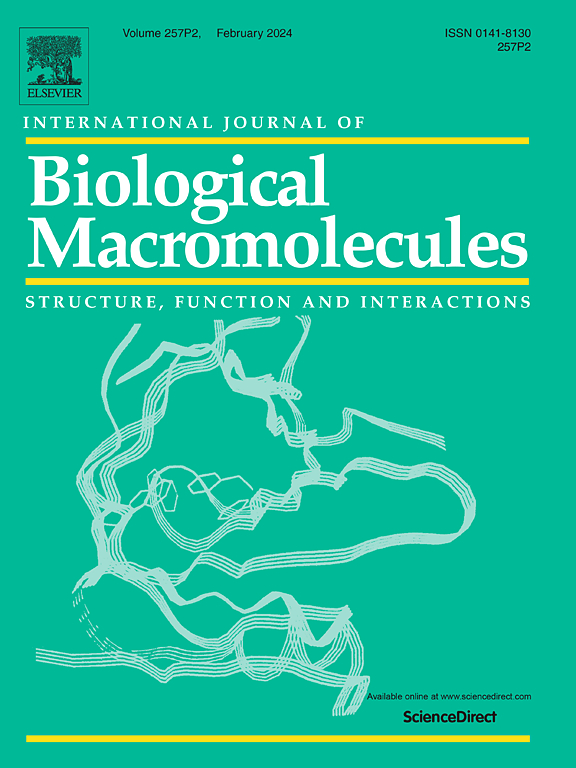基于羧甲基纤维素的聚集诱导发射抗菌材料的多功能应用。
IF 7.7
1区 化学
Q1 BIOCHEMISTRY & MOLECULAR BIOLOGY
International Journal of Biological Macromolecules
Pub Date : 2024-11-17
DOI:10.1016/j.ijbiomac.2024.137740
引用次数: 0
摘要
多糖在自然界中无处不在,通常对人体无害,而且与生物医学领域的各种组织高度兼容。这些特性使它们在多功能材料中的应用具有吸引力。本研究利用羧甲基纤维素(CMC)和ε-聚赖氨酸(ε-PL)成功合成了聚集诱导发射(AIE)抗菌材料(PLOCMC)。PLOCMC 不仅具有 AIE 特性,还具有室温磷光 (RTP) 现象。这种双重发射行为增强了其在化学传感和防伪方面的潜在应用。值得注意的是,PLOCMC 显示出较低的细胞毒性,并对典型的革兰氏阳性和革兰氏阴性细菌具有抗菌活性,使其成为一种针对多种细菌菌株的强效制剂。此外,PLOCMC 对 Fe3+ 离子和亚硝酸盐具有特异性反应,这表明它在食品安全和监测应用中具有潜在的实用性。本文章由计算机程序翻译,如有差异,请以英文原文为准。
Carboxymethylcellulose-based aggregation-induced emission antibacterial material for multifunctional applications
Polysaccharides are ubiquitous in nature, typically harmless, and highly compatible with various tissues in biomedical contexts. These properties make them attractive for use in multifunctional materials. In this study, the aggregation-induced emission (AIE) antibacterial material (PLOCMC) was successfully synthesized by carboxymethylcellulose (CMC) and ε-Poly-Lysine (ε-PL). PLOCMC exhibits not only the AIE property but also a room temperature phosphorescent (RTP) phenomenon. This dual emission behavior enhances its potential applications in chemical sensing and anti-counterfeiting. Notably, PLOCMC shows low cytotoxicity and exhibits antibacterial activity against typical Gram-positive and Gram-negative bacteria, making it a potent agent against a variety of bacterial strains. Additionally, PLOCMC demonstrates specific responsiveness to Fe3+ ions and nitrite, indicating its potential utility in food safety and monitoring applications.
求助全文
通过发布文献求助,成功后即可免费获取论文全文。
去求助
来源期刊
CiteScore
13.70
自引率
9.80%
发文量
2728
审稿时长
64 days
期刊介绍:
The International Journal of Biological Macromolecules is a well-established international journal dedicated to research on the chemical and biological aspects of natural macromolecules. Focusing on proteins, macromolecular carbohydrates, glycoproteins, proteoglycans, lignins, biological poly-acids, and nucleic acids, the journal presents the latest findings in molecular structure, properties, biological activities, interactions, modifications, and functional properties. Papers must offer new and novel insights, encompassing related model systems, structural conformational studies, theoretical developments, and analytical techniques. Each paper is required to primarily focus on at least one named biological macromolecule, reflected in the title, abstract, and text.

 求助内容:
求助内容: 应助结果提醒方式:
应助结果提醒方式:


